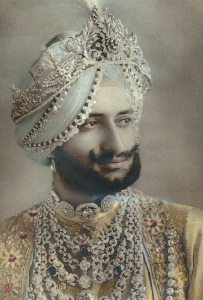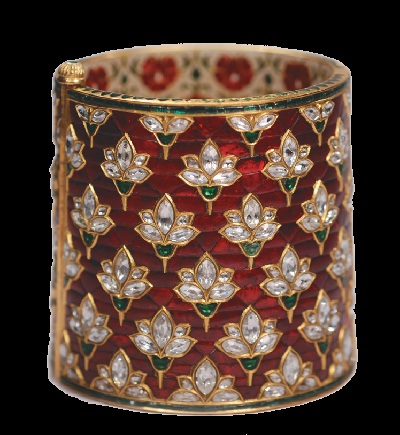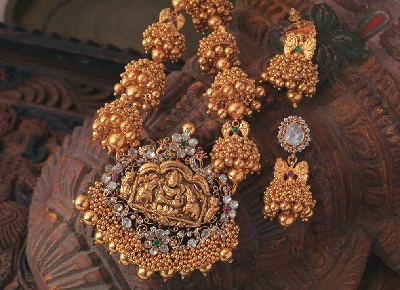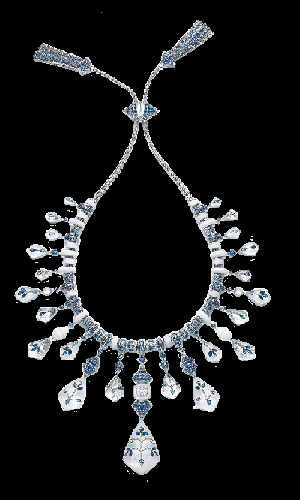The Gem & Jewellery Legacy Of India

India has been a constant source of inspiration for jewellers across the world. With painstaking workmanship and a design ethos that put intricacy and detailing above all else, the legacy of Indian jewellery was fuelled by an unequivocal passion for ornamentation, and the tradition
continues says Vijetha Rangabashyam
The marvel of Indian jewellery has left even the most jewellery-apathetic people in awe world over. In India, the desire to adorn oneself with ornaments is not a culture that was born on a whim, a few hundred years ago. The history of ornamentation in this country precedes history itself; some say 5000 years, but even that is just a conjecture. Tales about an invaluable piece of jewellery called ‘Syamantaka’ Mani in the Great epic Mahabharata is common knowledge. It emitted so much radiance that the wearer literally blinded his onlookers. So notorious is its legend that there is even a speculation that is in fact the infamous Koh-i-Noor diamond itself, which today is part of the Crown Jewels of the United Kingdom. There are one too many such references to jewellery in Hindu mythology. And so, it is not a wonder why India is the seat of precious jewellery and craftsmanship even today.
The legacy of Indian jewellery spurred an interesting conversation at Saffronart’s inaugural jewellery conference ‘The Timeless Legacy of Indian Jewels’ which was held in October with eminent personals from the industry shedding light on the timelessness of Indian jewellery. “Ever since I began my studies in jewellery, the powerful metaphors on adornment in Hindu mythology have remained with me. They are what set Indian jewellery apart  and makes each jewel a work of art,†says Dr. Usha R Balakrishnan, a leading jewellery historian. Jewellery is very much a part of every cultural milieu in India and we were also a country that was once fertile with rare diamonds and other precious gemstones.
Befittingly, India became famous in the World Map for its gemstones amidst traders and merchants across the world. Also, the Indian Monarchy had a voracious appetite for all things precious and jewellery was one of them. So, the intricate craftsmanship and skills we see today were developed at the courts of many a king, by their crown jewellers. “The range and variety of ornament forms in India are of cosmic proportions. Spanning a history of over 5000 years and spread across a geographical expanse of over 3 million sq km, adornment in India is actually a way of life. Jewellery is an integral part of every person in India; it is inseparable from the human body,†Usha adds.
The tangible evidence of jewellery-making can be traced back to the Indus Valley Civilization – some of the jewellery that is now exhibited in Delhi, at the National Museum, exudes utmost style and elegance that one is enamoured by the perfection that was achieved, even back then without the existence of modern technology. But jewellery in India holds a special place amidst connoisseurs in the world for this very reason - most intricate ones are still handcrafted. Much of the patterns and techniques we see in jewellery today dates back to the Indus Valley Civilization and with time, our skilled craftsman perfected their technique. “India was the first region to produce diamonds an d the interesting thing about that of course are their distinctive properties. Some of them are like ice cubes, so clear and transparent. These properties were in fact exclusive to diamonds of the Golconda region,†says Tom Moses, Executive Vice President and Chief Laboratory and Research Officer, GIA.

We were the land of diamonds and we popularised them to the world; in fact, we even invented the technique of diamond drilling and passed on the knowledge to other countries. “From time immemorial, the gems and jewellery of India have captured the imagination of travelers like Marco Polo and gem merchants like Jean Baptiste. The Tanjore Brihadeeswarar temple record the receipt of magnificent gifts in the form of jewellery and the inscriptions on the walls of the temple also has umpteen references of jewellery,†adds Usha.
Renowned Jewellery Crafts
Partash is an age-old decorative craft of inlaying on a piece of sculpted gold to create different patterns. This technique enhances the beauty of any metal, mainly gold on which it is predominantly found. Partash again is believed to have born in the court of Mughals around 500 years ago, but with the advent of the British Empire, the technique lost its prominence. This technique that completely involves hand tools is absolutely labour-intensive, as evidenced by the pieces of jewellery seen here. A very few jewellers have revived the ancient technique of Partash – Saboo Fine Jewels and House of Surana to name a few.
Meenakari known more commonly as enameling to the rest of the world is one of the greatest given to India by the Mughals. Originally invented in Persia, the Mughals carried this beautiful craft with them to India and popularised it. ‘Mina’ in Persian refers to the Heaven’s shade of azure and is the feminine derivative of ‘Minoo’. A Persian art, Meenakari spread to different parts of the world, but India, particularly Rajasthan, has made the art what it is today. The history behind how this regal craft inculcated by the Mughals found its way into Jaipur seems a bit hazy. The only plausible explanation may lie in the fact that the artisans who were well versed with the technique migrated to Jaipur after the downfall of the Mughal Empire and the demand for their craft in Jaipur garnered great recognition. A wider known reason for the prevalence of this craft in this city may be tied to the fact that Maharaja Man Singh, brought in these Meenakars in the 16th century from the courts of Lahore.
The exceptional skill has been since passed from one generation to another in Jaipur and even today only a very few artisanfamilies are familiar with the technique. “Today, the enamellists are adept with modern technology. But back in the day, they were so experienced that they knew exactly how long they should place the metal in the furnace to bring the desired colours or the temperature they should stick to in order to get a certain sheen in the enameling. It is such a detailed craft that has been passed over from one generation to another,†says Sudhir Kasliwal, CFO & Partner, The Gem Palace. The basic design is created by the designers. Then the kalamkars (engravers) along with Meenakars (enamellists) engrave the given design on the metal with enamel colours. The metal is the kept in a furnace with a temperature of 850 degrees, causing the colours to harden and blend with the metal. The ghotnawala (polisher) polishes the piece before passing it on to the Kundansaaz (stone setter). Metal oxides with a dash of glass powder create the enamel colours. Traditional Meenakari work is done on gold, while silver has become abundantly popular because of the cost factor. While Meenakari is popular in Jaipur, Banaras is popular for gulaabi meena (pink colour) and Lucknow is known for its blue and green Meenakari on silver. Pratapgarh is known for its glass Meenakari work. A traditional craft like Meenakari has not lost its charm over the years and can be seen amidst heritage jewellers across Jaipur and other pockets of India. The mélange of Meenakari and Kundan, popularly known as kundan-meena has such great demand amidst brides today.
Jadau jewellery is again an age-old craft ubiquitous in Jaipur, but it was brought to India by the Mughals. Today, every jeweller specialising in Jadau pieces have their distinct style. However, Jadau as what we see it today originated in Bikaner. Jadau involves heating of pure gold until its malleable, creating a frame, filling lac in the empty frame and then embedding stones as per the design. It is often combined with Meenakari and kundan and like many forms of jewellery craftsmanship, it is a cumbersome technique which involves a group of artisans. Jadau jewellery only uses polki stones also known as uncut diamonds in common parlance. “Jadau compared to modern jewellery with polished diamonds is inexpensive. Of course, Jadau has become more expensive now, but for 5 lakh rupees I can give you an entire bridal Jadau set but for the same money you can probably get just one big piece of diamond in modern jewellery. Also, Jadau is just so much more beautiful,†says Sudhir Kasliwal.

Tarakasi (filigree) is an intricate form of craft exclusive to Orissa. A 500-year-old craft, filigree in Orissa is mainly done with silver. The finished work closely resembles a lace pattern, an openwork design created with fine threads of silver or gold. Filigree work predominantly uses flower, animal and other motifs drawn from nature. In the west, mainly in Gujarat, Filigree goes by another term called Ras-Rava bearing gold wires (taar) laid on gold plates, small gold beads (rava) and twisted wire. Filigree jewellery is so popular in India that today the craft has spread to Kolkata and parts of Andhra Pradesh.
Pachchikam exclusive to the Kutch region of Gujarat draws influences from the 16th century European designs. However, it was given a definition and became a well-renowned art form by Indian artisans who till date are involved with it in Gujarat. The work involves encasing of semi precious stones and glasswork on silver in a simulated open-claw setting. Pachchikam jewellery is considerably cheaper as it uses only silver and today is propagated by very few jewellers.
Temple Jewellery found in South India, predominantly Tamil Nadu was initially found on temple idols and later on Bharatnatyam and Kuchipudi dancers who were associated with the temples. The stones used in Temple Jewellery are uncut rubies, emeralds and diamonds along with an adequate use of pearls. It is again a technique which involves just the hands and is only known to a select few in the Southern parts of India. Vadassery, a fishing hamlet in Kanyakumari still has over 400 artisans who are adept with this craft. The origin of the craft is not clear, however, it has been passed over through generations from the 17th century. “At Navrathan Jewellers we have been reviving the art form and that is one of the principle USPs of our brand. From the traditional addige (south Indian choker) to the maanga malai (mango necklace), we have brought in old world designs to the forefront,†says Gautam Chand Bafna, Managing Director, Navrathan Jewellery. From necklaces, earrings, amulets, nose rings, pendants to waist bands and even hair ornaments, Temple Jewellery comes in an array of designs. Most Temple Jewellery pieces use idols as motifs along with symbols borrowed from nature.

Prominent Jewellery Hubs
Though there are plenty of jewellery hubs in India, Jaipur today is considered the largest hub of gems and jewellery and rightly so. The princely city’s legacy when it comes to gems and jewellery is profound and it all goes back to the vision of Maharaja Mirja Raja Sawai Jai Singh, who decided to perceive Jaipur as the City of gems. The persons involved in jewellery business were more than encouraged by the king and had their best interest, which is why even today, Jaipur continues to flourish in the trade. From cutting and polishing a variety of gemstones to perfecting techniques such as Meenakari, Jaipur stands in the forefront. Though India has always been a hub for cutting and polishing of gemstones, a substantial amount of gemstones export began in 1914 and a lot of which came from Jaipur itself under the reign of Maharaja Man Singh. About 90 per cent of the emeralds world over are cut in Jaipur – the labour intensive craft of jewellery making, beads-making, carving, straining and more can only be found here and nowhere else in the world. “It is where Meenakari and Jadau jewellery became famous.
Of course now it has been practiced in various parts of India but Jaipur is Jaipur at the end of the day,†adds Sudhir Kasliwal. Surat again is of great historical importance when it comes to gems and jewellery. It was indeed a principle city of the Mughal Empire and its topographical advantage made it extremely enticing for traders and merchants alike. The first diamondcutting factory was established in 1938 in Navsari, a neighbouring town of Surat. The factory employed all of 65 workers and today we know that Surat is the nucleus when it comes to diamond cutting. Although today, Mumbai has also become a huge centre for diamond cutting and polishing. Kolkata remains to be the hub for plain gold jewellery while Nellore and Belgaum together are the biggest suppliers of studded jewellery to Tamil Nadu.
The Enduring Influence of Indian Jewellery on the World
International High Jewellery houses took notice of India’s rich palette of gemstones and its design aesthetic in the late 19th century and early 20th century. The flamboyant Royalty of India would often pay a visit to European Maisons like Cartier and Van Cleef & Arpels to have their stones set in the latest Art Deco Style. In due course, the European High Jewellery houses became deeply infatuated with quintessential Indian colours, textures and motifs. This can be seen even today in collections like Bleu de Jodhpur by Boucheron. And of course, Cartier’s Indian connection is profound and the brand continues to revel in its Indian influence even today in many of its prized pieces. What caught the attention of these Ateliers about Indian gemstones were the colours, the size and the unapologetic mix and play of different gemstones. “India has been inspiring every aspect of lifestyle and luxury internationally. Van Cleef & Arpels used Paisley motifs abundantly, reminiscent of the Indian turban ornaments, encrusted with precious gemstones like emeralds and rubies accented with diamonds,†says Francois Arpels from the Arpels family. The famed Cartier tutti-frutti necklace is evocative of Indian motifs of leaves and blossoms, using resplendent gemstones like rubies, emeralds and sapphires. “I have always found it interesting that Cartier and India are so indelibly linked. This country has so much of Cartier’s DNA. The Indian inspired pieces like the tutti-frutti are still the most popular ones Cartier has ever made. The commission from the Maharajas of India still remains the largest in Cartier’s history of orders,†said Francesca Cartier Brickell, granddaughter of Jean Jacques Cartier, one of the Cartier brothers.
Rare Auction Pieces
Â
The Taj Mahal Necklace by Cartier
This beauty was sold as part of the ‘Elizabeth Taylor’ collection at Christie’s – an inscribed, heart-shaped, table cut diamond in a red stone and jade mount set with table-cut diamonds. The backside of the pendant is decorated with enamel latticework motif. The pendant is suspended on a gold chain set with cabochon rubies and old mine-cut diamonds, mounted in gold, inscribed heart-shaped table-cut diamond bearing the Islamic date 1037 [1627-1628]. The piece was sold for a whopping price of $8,818,500, the highest to be sold at any auction.
An enamelled and gem-set Navratna necklace
This 18th century octagonal Navratna necklace with a floral pendant has coloured gemstones namely white sapphire, pink coral, emerald, ruby and diamond. Navratna is heavily associated with the realm of Hindu astrology where each gemstone symbolizes a different planet and in turn a deity. Navratna is said to bring great prosperity to the wearer and is also believed ot have protective powers. The neck piece was sold at Sotheby’s for GBP 15,000.
Diamond and enamelled bracelets (dastband)
This flexible pair of bracelets from South India is decorated with pale blue, green, red, white and blue enamels and is set with foliate diamonds. The ends of the bracelets are in the shape of makara heads with eyes studded with agates. Makara refers to aquatic creature and a lot of such motifs were used in South Indian jewellery. Also, this proves that enameling as a technique also reached South India from the North.
Ruby Manga Malai
A necklace with mango motifs replete with diamonds, rubies and emeralds – this design is exclusive to South India and is worn by women during special occasions. This is a quintessential Temple Jewellery piece and in India, mangoes are a symbol of love and fertility. The necklace is set with cabochon rubies and they are set in kundala-velai technique, the same as Kundan setting of North, where lac filled sheet of gold is used to secure the gem. This necklace hails from the Chola period. It was sold for GBP 84,100.
Gold Parade Necklace
Commissioned by a wealthy patron, this piece epitomizes luxury and the beauty of the Mughal Meenakari work. It has one hundred brightly cut diamonds and colourful enamel work on the reverse. The necklace is meant to rest comfortably on the wearer’s chest owing to the flexible chain. The 3D peacock pendant is characteristic of Indian aesthetic, where it purports prosperity. Each diamond was cut and foil-backed to bring out maximum radiance. The piece was sold for GBP 236,500.
Maharani Torque Necklace (Hasli)
This 19th century Maharani necklace hails from the Bikaner region of Rajasthan and upholds the
Kundan tradition where gems have been set into gold that was melted into malleable foil. The necklace is encrusted with diamonds and rubies and further enhanced by a strand of emerald beads on the bottom. All the designs are indicative of a possibility that this could have belonged to a Royal family. Hasli means Hansuli meaning collar-bone in Hindi and this ornament is exclusive to Rajasthan. The predominant use of green also represents the heavy Mughal influence on the jewellery.
Be the first to comment